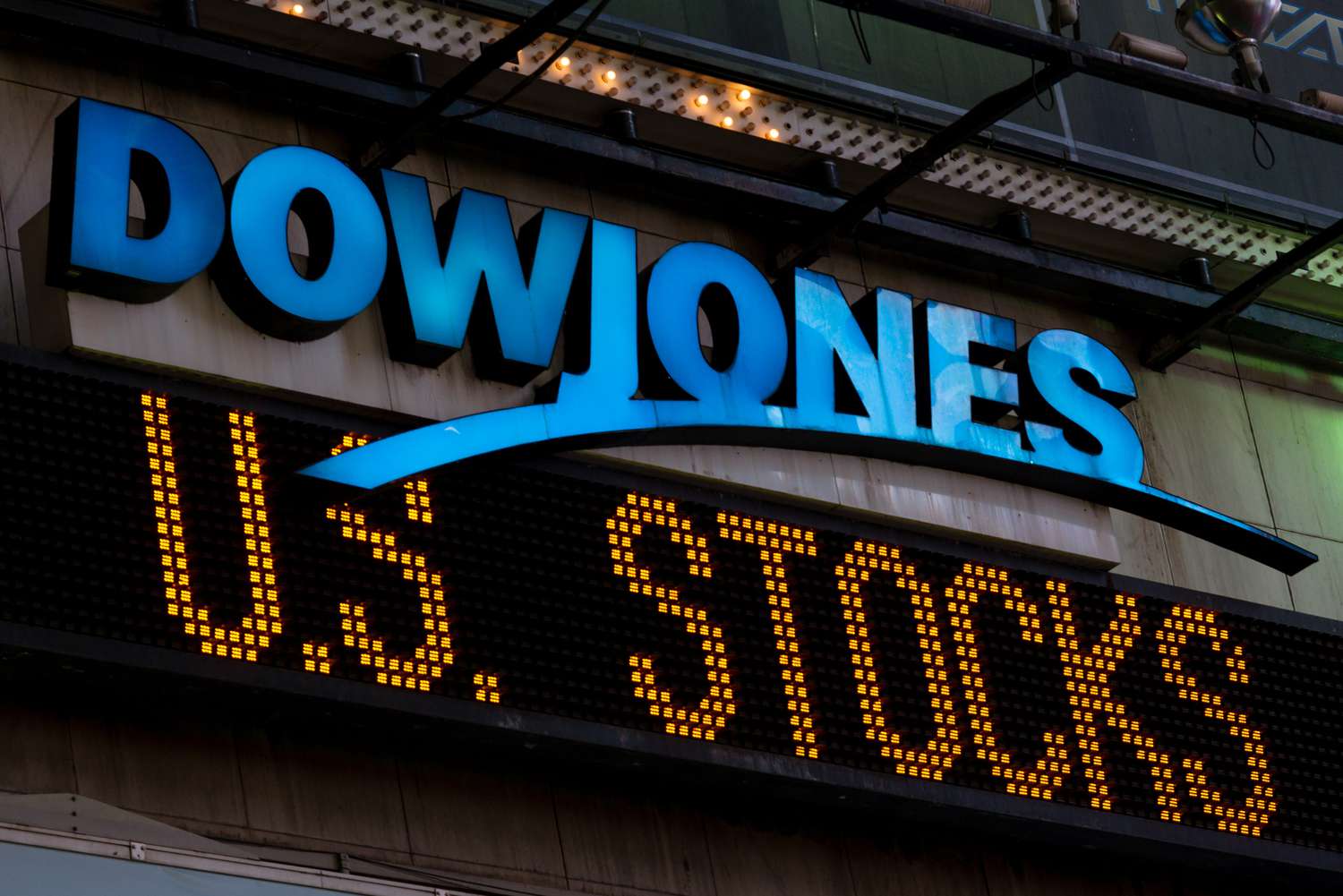Business
Unveiling the Secrets of Dow Jones: What Every Investor Should Know

Introduction to the Dow Jones Industrial Average (DJIA)
Welcome to the exhilarating world of investments, where fortunes can be made and dreams can come true. As an aspiring investor or seasoned financial guru, you’ve probably heard whispers about the Dow Jones Industrial Average, commonly referred to as the DJIA. But what exactly is this mystical-sounding index that holds so much sway over the global markets? Get ready to uncover its secrets and arm yourself with invaluable knowledge that every investor should possess.
The Dow Jones Industrial Average (DJIA) is a renowned stock market index that serves as a barometer for the overall performance of the U.
S. stock market. It’s like a compass guiding investors through turbulent waters, offering insights into prevailing trends and predicting potential opportunities or risks ahead. This fascinating index has been instrumental in shaping investment strategies since its inception back in 1896.
So, grab your magnifying glass and let’s embark on a historical journey to unravel how this influential benchmark came into existence. From humble beginnings to becoming one of the most widely followed indicators worldwide, we’ll explore its evolution throughout history and witness firsthand how it has adapted to modern times.
History and Evolution of the Dow Jones
The history and evolution of the Dow Jones is a fascinating journey that spans over a century. It all began in 1884 when Charles Dow, along with his business partner Edward Jones, founded the company that would eventually become the Dow Jones & Company. Their vision was to create an index that would track the performance of leading industrial companies in the United States.
In May 1896, they launched their flagship index, known as the Dow Jones Industrial Average (DJIA). At its inception, it consisted of just 12 stocks representing various industries such as railroads, cotton mills, sugar companies, and tobacco manufacturers. The purpose was to provide investors with a snapshot of how these key sectors were performing.
Over time, as the economy grew and new industries emerged, so did the composition of the DJIA. Today, it consists of 30 blue-chip companies across various sectors including technology giants like Apple and Microsoft, financial institutions like JPMorgan Chase and Goldman Sachs.
Throughout its evolution, one thing has remained constant –the ability of the DJIA to serve as a barometer for overall market conditions. Investors have come to rely on its movements as an indicator of economic health or potential risks.
How the DJIA is Calculated
Understanding how the Dow Jones Industrial Average (DJIA) is calculated can provide valuable insights into the dynamics of this widely followed index. The DJIA is a price-weighted average, which means that it gives more weight to higher-priced stocks. To calculate the index, the prices of 30 major U.
S. stocks are added together and divided by a divisor.
The divisor is used to maintain continuity when there are stock splits, dividends, or other corporate actions that may impact the price of a component stock. This ensures that changes in individual stock prices do not disproportionately affect the overall index value.
The calculation method used for the DJIA has its advantages and disadvantages. On one hand, it provides a simple way to track market trends and gauge investor sentiment. However, critics argue that it fails to accurately represent broader market performance due to its narrow focus on just 30 large-cap stocks.
Investors should keep in mind that while the DJIA can be helpful for tracking general market movements, it may not be as comprehensive as other indexes like the S&P 500 or Russell 2000.
Understanding how the DJIA is calculated can give investors important context when interpreting its movements. While it has limitations as an investment tool, it remains an influential benchmark in financial markets worldwide.
Understanding the Components of the DJIA
Understanding the Components of the DJIA
The Dow Jones Industrial Average (DJIA), commonly referred to as “the Dow,” is made up of 30 large, publicly traded companies. These companies are carefully selected by the editors of The Wall Street Journal and are meant to represent a broad range of industries in the U.
S. economy.
So, who exactly makes it onto this prestigious list? Well, some familiar names you might recognize include Apple, Microsoft, Boeing, and Coca-Cola. These companies have proven themselves to be leaders in their respective fields and have a significant impact on the overall stock market.
However, it’s important to note that being included in the DJIA doesn’t necessarily mean a company is performing well financially. Rather, it serves as an indicator of market trends and investor sentiment towards these particular stocks.
As an investor, understanding which companies make up the DJIA can provide valuable insights into current market conditions. By analyzing how these individual stocks perform over time, you can gain a better understanding of broader economic trends and potentially make informed investment decisions.
It’s worth mentioning that changes to the components of the DJIA do occur from time to time. Companies may be replaced if they become less representative of their industry or if they experience financial difficulties.
Impact of Market Trends on the DJIA
The Dow Jones Industrial Average (DJIA), often referred to simply as the Dow, is not immune to the influence of market trends. In fact, it is highly sensitive to shifts in investor sentiment and broader economic conditions.
When positive market trends prevail, such as strong corporate earnings reports or optimistic economic data, the DJIA tends to rise. This can be attributed to increased confidence among investors, leading them to buy stocks and push prices higher. Conversely, during periods of negative market trends like recession fears or geopolitical tensions, the DJIA may experience declines as investors become more risk-averse and sell off their holdings.
It’s important for investors to understand that while the DJIA provides a snapshot of overall market performance, its movement is influenced by a relatively small number of large-cap stocks. Therefore, changes in these individual companies can have a significant impact on the index as a whole.
Additionally, global events and macroeconomic factors also play a role in shaping market trends that ultimately affect the DJIA. Factors such as interest rate decisions by central banks or trade disputes between nations can sway investor sentiment and subsequently impact stock prices within the index.
In conclusion,
investors should keep a close eye on various market indicators
in addition to monitoring
the movements of
the DJIA alone. By considering multiple sources of information,
they can gain comprehensive insights into
market trends that could potentially affect their investment portfolios.
How to Use the DJIA as an Investment Tool
When it comes to using the Dow Jones Industrial Average (DJIA) as an investment tool, there are several strategies and approaches that investors can consider. One way to utilize the DJIA is by tracking its performance over time and identifying trends or patterns that may indicate potential opportunities for buying or selling stocks.
By monitoring the movements of individual companies within the index, investors can gain insights into broader market trends and make informed decisions about their portfolios. For example, if a particular industry or sector is experiencing growth, it may be worth exploring investments in related companies.
Another strategy is to use the DJIA as a benchmark for evaluating the performance of your own investments. By comparing your portfolio’s returns against those of the index, you can assess how well your investments are performing relative to the overall market.
Additionally, investors can leverage exchange-traded funds (ETFs) that track the DJIA. These funds allow individuals to gain exposure to all 30 stocks in one convenient investment vehicle.
It’s important to note that while using the DJIA as an investment tool has its benefits, it also has limitations. The index only includes 30 large-cap companies and does not represent every sector of the economy. Therefore, relying solely on this index may not provide a comprehensive view of market conditions.
Risks and Limitations of Using the DJIA
Risks and Limitations of Using the DJIA
While the Dow Jones Industrial Average (DJIA) has been a popular tool for investors, it’s important to be aware of its risks and limitations. One key risk is that the DJIA only includes 30 large-cap stocks, which may not represent the overall market accurately. This limited sample size can lead to skewed results and misinterpretation of market trends.
Another limitation is that the DJIA is price-weighted, meaning that stocks with higher prices have a greater impact on the index’s movement. This can lead to an overemphasis on certain companies’ performance, potentially distorting the overall picture.
Additionally, changes in stock composition within the DJIA can also create challenges. When a company is removed from or added to the index, it can cause sudden fluctuations in its value as investors adjust their portfolios accordingly.
Furthermore, relying solely on DJIA data may overlook other important factors such as sector-specific trends or global economic indicators that could affect investment decisions.
It’s crucial to understand that past performance does not guarantee future results. The historical success of companies included in the index does not necessarily indicate continued growth or stability.
In conclusion…
While using the Dow Jones Industrial Average as an investment tool can provide valuable insights into market trends and investor sentiment, it’s essential for investors to consider its limitations and use additional indicators for a more comprehensive analysis.
Alternatives to the DJIA for Investors
Alternatives to the DJIA for Investors
While the Dow Jones Industrial Average (DJIA) is one of the most widely recognized stock market indexes, there are several alternatives that investors can consider when building their portfolios. These alternative indices provide different perspectives on the market and may be better suited to certain investment strategies.
One popular alternative is the S&P 500 index, which tracks the performance of 500 large-cap stocks across various sectors. The S&P 500 offers a broader representation of the U.
S. stock market compared to the DJIA’s focus on just 30 companies. This diversity can provide investors with a more comprehensive view and potentially reduce risk.
Another option is the Nasdaq Composite Index, which includes over 3,000 stocks listed on the Nasdaq exchange. It primarily represents technology-related companies and has historically shown strong growth potential. For those interested in investing in this sector specifically, Nasdaq could be an attractive alternative.
Investors looking for global exposure might consider indices like MSCI World or FTSE All-World Index. These benchmarks include thousands of stocks from around the world and offer a broader perspective on international markets.
For those focused on specific industries or themes, there are also specialized indices available. Examples include biotechnology-focused indices like NASDAQ Biotechnology Index or clean energy-focused ones like Wilder Hill Clean Energy Index.
It’s important to note that each alternative index has its own methodology and weighting criteria. Therefore, it’s crucial for investors to understand these differences before making any investment decisions.
In conclusion,
While many investors rely on the Dow Jones Industrial Average as a benchmark for their investments, it’s essential not to limit oneself solely to this index. Exploring other alternatives such as S&P 500, Nasdaq Composite Index, MSCI World or industry-specific indices can provide additional insights into different segments of the market and potentially enhance portfolio diversification strategies
Conclusion
Conclusion
The Dow Jones Industrial Average (DJIA) has a rich history and is considered one of the most influential stock market indexes in the world. Understanding how it works and its limitations can be valuable for investors looking to make informed decisions.
Throughout this article, we explored the origins of the DJIA and how it has evolved over time. We also delved into the intricacies of calculating the index and understanding its components.
We discussed how market trends can impact the performance of the DJIA, highlighting its role as a barometer for overall market health. Additionally, we explored how investors can use this index as a tool to gain insights into specific industries or sectors.
However, it’s important to recognize that relying solely on the DJIA may have some risks and limitations. The limited number of stocks included in the index may not fully represent all sectors or companies in the market. Furthermore, price-weighted indexing methodology may skew results and overlook factors such as company size or fundamentals.
Business
Thoughtful Corporate Gift Baskets That Leave a Lasting Impression

Good business relationships are built on trust, consistency, and a little bit of human warmth. Clients stick around when they feel appreciated, not just invoiced. Employees put in extra effort when they know someone notices their work. Business partners invest more when the relationship feels mutual and respectful. None of this happens automatically.
Keeping clients happy, employees motivated, and business partners engaged takes more than solid work and fair pricing. It takes showing people they matter beyond what they contribute to the bottom line. Corporate gift baskets do this without the awkwardness that can come with business gifts. Pick the right one, and people remember it long after they’ve enjoyed the last chocolate or cracker.
Why Should You Care About Business Gifts?
Business gift baskets work because they land in that sweet spot between too formal and too casual. They’re appropriate for professional settings but don’t feel cold or obligatory. They suit different people without needing to know their life story. They show thought without making anyone feel like they owe something back. And they give people actual enjoyment, which creates good feelings attached to the business relationship.
The effects pop up in random ways. A client brings up a conversation about those amazing pretzels during a call three months later. An employee mentions the craft beer they shared with their spouse. A business partner still uses that bamboo cutting board and thinks about the company that sent it. These aren’t dramatic moments, but they keep positive feelings alive in ways that regular business dealings just can’t.
What Goes Into a Good Basket for Professional Relations
Grabbing a bunch of random snacks and cramming them into a basket doesn’t cut it. The difference between a simple and an extraordinary gift comes down to how everything fits together. Look at something like the Raspberry Truffle & Brie Luxury Box. It’s got Italian red wine, cheddar brie spread, water crackers, pesto, raspberry chocolate truffles, and dipping pretzels on a wooden tray. Everything works together, whether someone wants to set up a whole spread or just grab a snack here and there.
The trick is mixing stuff people recognize with things that surprise them. Everyone knows that good wine and quality chocolate taste great. That creates instant appreciation. But then there are items like raspberry truffles or specialty pesto that add something unexpected and memorable. This combo means people like the gift right away and also have something interesting to talk about later.
How it looks counts, especially in business. An engraved bamboo tray or solid wooden serving board shows that real effort went into choosing the gift. These aren’t throwaway containers that hit the trash once the food’s gone. They’re useful pieces that get pulled out regularly. Every time someone uses that tray for guests, there’s a little reminder of where it came from. That extended visibility makes the gift keep working long after the first impression.
Different Situations Need Different Approaches
A gift for a major client shouldn’t look exactly like what goes to a new hire. Senior executives expect different things from department teams. Corporate gift baskets adjust to these different needs better than most options because they’re naturally versatile.
Big-ticket relationships need gifts that show their importance without getting weird. The Luxe Golden Chocolate Collection hits that mark. Wine, Lindt chocolates, icewine chocolates, Belgian truffles, pesto, crackers, and pretzels on an engraved tray say that the relationship matters while staying professional. It’s substantial without crossing any lines.
Team gifts work differently. The Premium Beer & Gourmet Collection makes sense for groups because it’s built for sharing. Four craft beers, Danish Brie, olives, different crackers, chocolate truffles, cheese knives, and a cutting board give teams plenty to enjoy during breaks or after-hours celebrations. The variety means different preferences are covered, and there’s enough for everyone to actually enjoy it together.
When something worth celebrating happens, the gift should match that energy. The Rise & Shine Champagne Basket does exactly that. Sparkling wine, pepper crackers, cheddar brie spread, Belgian chocolates, Greek honey, pancake mix, pretzels, Ajvar spread, and a bamboo tray create celebration vibes without being over-the-top. It feels festive but still professional.
Handling Lots of Gifts Without Losing the Thread
End-of-year gifting, company anniversaries, and appreciation campaigns can mean sending gifts to dozens or hundreds of people. Shopping individually for that many becomes impossible. Bulk ordering corporate gift baskets handles the volume without turning gifts into impersonal gestures.
The practical side is huge. One order covers everyone. Delivery gets coordinated so things arrive when they should. Billing happens once instead of tracking tons of separate charges. All this saves time and headaches that can go toward actually running the business.
Keeping things consistent across bulk orders matters more than it might seem. Everyone gets the same quality. Everything looks equally professional. This consistency prevents the unintentional dissatisfaction that can happen when shopping for lots of people individually, even with the best intentions.
Customized Gifts for Your Clients and Employees
The customization options with business gift baskets make smart personalization doable. Start with a good base and adjust details based on actual knowledge. A client who loves wine gets a nicer bottle added. Adding a real note changes everything. That’s the difference between a polite thank-you and a strengthened connection.
Sending corporate gift baskets during the holidays shows clients and employees they’re thought about when things wind down. It’s basic professional courtesy that keeps relationships warm.
Quality Corporate Gift Baskets That are Useful
Corporate gifting isn’t about buying loyalty with strategic presents. It’s recognizing that business relationships are still relationships, and relationships need mutual respect and genuine appreciation to thrive.
Clients who feel truly valued tell others about it. Quality corporate gift baskets support these patterns by making thoughtful gestures realistic at scale. They let businesses show appreciation without eating up tons of time or resources.
Business
Inside London’s Ultra-Exclusive Membership Venues And What Sets Them Apart

London has endless places to eat, drink, shop, or just walk. But there’s another layer you don’t just stumble into. Behind discreet doors and quiet facades are the membership-only venues where the tone shifts completely. These are the spaces built not just for service, but for status. What actually makes them different? That’s what we’re looking at here.
A Tradition Of Privacy
Membership venues in London aren’t a modern idea. They trace back centuries, when society circles built private rooms to gather, talk, and do business away from the noise outside. The point wasn’t just comfort, it was privacy. Who you were seen with mattered. Where you were seen mattered.
That hasn’t really changed. People still look for rooms that feel cut off, where the outside only comes in if you let it.
Doors That Don’t Open For Everyone
One of the first things that sets these places apart is the entry itself. You can’t simply decide to walk in. There’s usually an application, sometimes a waiting list, sometimes even a recommendation needed. It’s not only about the money, though that obviously plays a role. It’s about who fits, who adds to the space, who doesn’t break the atmosphere.
That careful selection process is what builds the sense of belonging. The idea that, once inside, everyone else has gone through the same filter. It makes the room feel smaller, tighter, more protected.
Interiors That Tell A Story
Step inside one of these venues and the details matter. Heavy wood, plush seating, dim light in some cases, bold modern design in others. It’s not just décor for the sake of it.
Some lean into the past — portraits on the walls, shelves of old books, chandeliers that look like they’ve been there forever. Others flip it, all clean glass, sharp design, shifting art. Either way, the design says: you are not in an ordinary restaurant or lounge. This is something else.
And often you’ll find a mix of old and new under one roof, a Georgian townhouse hiding a minimalist dining room inside. That blend is very London — tradition layered with modern edge.
Service That Remembers
Another difference is the staff. In exclusive venues, service runs deeper than carrying drinks or delivering plates. The best staff remember names, preferences, even conversations from weeks before. There’s a continuity to it.
Regulars don’t need to order twice. They sit, and their drink appears. A dish they loved months back reappears without them asking. That memory — the feeling of being known — is what separates these spaces from anywhere else.
And because membership means you’re likely to return again and again, the staff build relationships that feel almost personal.
Dining Beyond Food
Food is always part of the picture, but it isn’t just about the menu. The kitchens here work to bring more than taste — presentation, atmosphere, and exclusivity tie in. Some menus are kept quiet, known only to those who’ve sat down to eat. Seasonal changes are expected, with ingredients sourced at the very top end.
Meals become events. A table booked isn’t just for eating, it’s for hosting, for impressing, for marking something. The space itself becomes a backdrop, amplifying whatever reason brought you there.
Networks And Conversations
What really draws people to membership venues is the network. The walls protect conversations that don’t belong on a public street. Deals are made here. Partnerships are built here. Sometimes it’s casual talk over a glass of wine, sometimes it’s major decisions sketched on a napkin.
It’s not networking in the forced sense, either. The filter at the door means you’re already among peers, or people whose paths matter to yours. That makes interactions feel organic, more natural, even if everyone knows why they’re there.
Culture, Art, And Atmosphere
Many of London’s membership spaces lean heavily on culture. Art collections line the walls. Books fill shelves you’re free to browse. Some even commission new work just for their rooms. A Tape London table means access to some of the best private live performances by the biggest celebrities.
This cultural layer is important. It turns the venue into more than a place to eat and talk. It becomes a backdrop for creative energy, something members can point to as part of their own lifestyle.
Walking through, you often feel that mix — one room might have jazz in the background, another a painting worth millions hanging unannounced on the wall. It’s understated but deliberate.
The Balance Of Old And New
London does something special with its exclusive venues. Old and new sit side by side. A building might date back centuries, with ties to politics or art, but the inside keeps getting redone to match the times. That mix — history at the door, modern comfort inside — gives these places their pull. You step through the door and feel the weight of the past, but sit down in a room that feels very much of the present.
Why People Keep Coming Back
For members, the appeal isn’t just one thing. It’s the mix of things: privacy, recognition, design, food, the people in the room. It’s knowing you’ve got a space waiting for you whenever you want it.
It’s also the stories. Everyone leaves with something. A conversation worth remembering, a meal that stayed with them, a moment tied to that room and nowhere else. Those stories stick to the place.
The Subtle Power Of Belonging
At its core, what sets these venues apart is the feeling of belonging to something rare. The outside world can feel chaotic, public, unpredictable. Step inside here and it’s curated, contained, predictable in the best way.
You know the people beside you are there for similar reasons. You know the staff are ready before you ask. You know the design, the culture, the atmosphere is tuned to a level that doesn’t exist outside those doors.
That’s why the names of these places matter. They become shorthand. Mention them and people instantly understand what circle you move in. Sometimes it’s low-key, sometimes it’s shown off. But there’s always meaning behind it.
Looking Ahead
Exclusive venues in London aren’t disappearing. If anything, they’re becoming more sought after as the city grows busier and noisier. The desire for spaces set apart, where life feels slowed down and carefully managed, is only getting stronger.
Future changes will likely blend technology and tradition — digital tools for access or booking, alongside timeless interiors and old-school service. Sustainability will come into play as well, with pressure to align luxury with responsibility.
But the core appeal won’t shift. These are spaces for privacy, for recognition, for conversations that matter. They are rooms where life happens differently, quieter but somehow bigger at the same time.
Business
The Troubling Phenomenon of Pastors Selling Land in Heaven: Faith, Money, and Accountability

In a world where faith communities often rely on trusted spiritual leaders, reports of pastors promising heavenly real estate in exchange for donations or purchases have emerged with unsettling frequency. The notion of “selling land in heaven” is not just a quaint parable turned sales pitch; it touches on theology, ethics, church governance, and the vulnerable finances of believers. This article examines the phenomenon from multiple angles: how it happens, why it resonates for some, the risks involved, and practical ways to protect congregants and promote accountability.
What It Means to “Sell Land in Heaven”
Defining the Core Idea
- The phrase often describes attempts by a religious leader to monetize spiritual promises by claiming that donations, purchases, or specific financial acts will secure a tangible reward in the afterlife.
- Common patterns include:
- Promises of wealth, health, or favor in return for large gifts or “seed money.”
- Taxing or labeling certain donations as “spiritual investments” that guarantee heavenly returns.
- Framing ongoing financial commitments as foundational to personal salvation or community blessing.
The Theology Some Use to Justify It
- The practice draws on misinterpretations of prosperity gospel, indulgences, or ritualized acts of giving as merit-based currency.
- In some cases, leaders use persuasive rhetoric about spiritual capitalism: “Heaven’s inventory is stocked by your generosity today.”
Distinguishing Between Generous Giving and Exploitative Claims
- Healthy church giving often arises from voluntary, informed giving tied to transparent budgeting and mission-focused needs.
- Exploitative pitches tend to:
- Create a sense of coercion or isolation for those who cannot participate financially.
- Use fear-based language about sin, punishment, or divine withheld blessings.
- Offer vague or unverifiable “returns” that cannot be measured in tangible outcomes.
Why This Practice Persists
Psychological and Social Drivers
- Belonging and identity: For many, church affiliation provides community and purpose; compelling promises can reaffirm that belonging.
- Hope and agency: In uncertain times, people crave assurance. Promises of heavenly rewards can feel hopeful, even if unfounded.
- Authority and trust: Charismatic leaders wield influence; congregants may defer to perceived spiritual expertise.
Economic Incentives and Organizational Dynamics
- Revenue streams: Some churches rely on donations for operational viability, renovations, or ambitious programs.
- Longevity of leadership: In systems with centralized leadership, a single pastor’s vision (and finances) can dominate decision-making.
- Power dynamics: Financial control can translate into influence over congregants’ personal lives and choices.
The Ethical and Legal Landscape
Ethical Boundaries for Religious Leadership
- Most faith traditions emphasize stewardship, humility, and care for the vulnerable.
- Ethical concerns arise when faith is weaponized for financial gain, or when manipulation, coercion, or deception is used.
Legal and Regulatory Considerations
- In many jurisdictions, religious organizations enjoy certain tax exemptions. This status comes with accountability expectations, transparency requirements, and anti-fraud protections.
- Legal questions can arise around:
- Misrepresentation or fraud if promises imply monetary sales for heavenly outcomes.
- Consumer protection issues when individuals are marketed goods (even if intangible) under false pretenses.
- Nonprofit governance standards, including fiduciary duties, conflicts of interest, and financial disclosures.
Real-World Impacts: Consequences for Congregants
Financial Harm
- Congregants may deplete savings, incur debt, or forego essential expenses to meet donation targets.
- Wealth disparities can widen, with vulnerable members disproportionately affected.
Spiritual and Emotional Harm
- Trust erodes when promises fail or are revealed as transactional.
- Feelings of guilt, shame, or spiritual injury can linger long after a sermon.
Community Trust and Institutional Health
- Word spreads beyond a single church, affecting broader perceptions of religious institutions.
- Donor fatigue and skepticism can hinder legitimate fundraising and mission work.
Detecting and Responding to Exploitative Practices
Early Warning Signs
- Consistent use of “seed faith” language tied to specific monetary commitments.
- Pressure tactics: “If you love God, you will give…” or guilt-based messaging.
- Promises that prayer or sacrifice will guarantee specific, verifiable outcomes in heaven.
- Lack of transparency around finances, budgets, and how funds are used.
Practical Steps for Congregants
- Request transparent financial reporting: budget outlines, how donations are allocated, and measurable outcomes.
- Seek independent oversight: establish or support a finance committee with diverse leadership.
- Compare claims with core doctrine: consult multiple trusted theological sources to evaluate the claims.
- Practice informed giving: avoid pressure-filled decisions; take time to reflect and consult mentors or advisors.
Steps for Church Leadership and Governance
- Establish clear ethical guidelines: codify boundaries between spiritual leadership and financial solicitation.
- Build robust governance structures: independent treasurers, audit processes, and policies on conflicts of interest.
- Foster accountability culture: open forums, grievance mechanisms, and whistleblower protections.
- Prioritize education: equip congregants with media literacy and critical thinking about fundraising rhetoric.
Practical, Evidence-Based Alternatives to Faith-Based Real-World Costs
If a faith community seeks to support its mission without compromising ethical standards, here are constructive approaches:
- Transparent stewardship campaigns: clearly articulate needs, timelines, and outcomes; provide regular financial updates.
- Mission-driven fundraising: tie gifts to specific, auditable programs (e.g., scholarships, community services) with measurable impact.
- Membership-based budgeting: align programs with real, documented community needs and capacity, avoiding coercive tactics.
- Independent audits: annual external audits and published audit reports to build trust.
- Beneficiary-centered models: ensure programs prioritize the well-being and autonomy of those served, with consent and dignity at the forefront.
Case Studies: Lessons from the Field
Note: This section offers generalized, anonymized patterns to illustrate insights without naming specific individuals or churches.
- Case A: A growing church faced rapid expansion and instituted a bold “project seed” fundraiser. After initial enthusiasm, financial shortfalls and member complaints mounted. An external audit revealed a lack of budget transparency, leading to policy reforms and the creation of an independent oversight board.
- Case B: A pastors’ council implemented a transparent giving policy, separating spiritual messaging from financial pitches. The initiative included annual financial disclosures and a code of conduct, rebuilding trust among congregants.
- Case C: A denomination issued a ethics charter prohibiting fundraising practices that promise celestial benefits. The charter was accompanied by training on ethical stewardship and a clear complaint mechanism.
FAQs
- Is it illegal for a pastor to promise heaven in exchange for money?
- Legality varies by jurisdiction. Some practices may violate fraud or consumer protection laws, especially if misrepresentations are involved. Ethical concerns remain even if there isn’t a specific statute broken.
- How can I protect myself from exploitative fundraising in my church?
- Seek transparent financial information, ask questions about how funds are used, advocate for independent audits, and discuss concerns with trusted leaders or denomination authorities.
- What should I look for in a healthy church fundraising strategy?
- Clarity, consent, accountability, measured outcomes, and alignment with the mission. Fundraising should inform and empower, not coerce or promise guaranteed spiritual returns.
- How can churches balance generosity with ethical fundraising?
- Emphasize stewardship education, transparent budgets, and community-focused initiatives. Avoid language that implies guaranteed heavenly rewards tied to gifts.
- If I suspect fraud in a religious organization, what should I do?
- Document concerns, seek counsel from trusted advisors, and report to appropriate authorities or denominational oversight bodies. If there are imminent risks to individuals, contact local authorities.
- Are there positive models for faith-based fundraising?
- Yes. Models that prioritize transparency, accountability, and mission impact—such as project-based campaigns, matched giving, or endowments—toster trust and long-term sustainability.
- How can denominational bodies help prevent these practices?
- By issuing ethical guidelines, providing training, establishing independent audit mechanisms, and creating safe channels for reporting concerns.
Conclusion: Navigating Faith, Finance, and Integrity
The temptation to frame heavenly outcomes as commodities is powerful in some contexts. Yet the integrity of religious communities hinges on a careful balance between generosity and accountability. Faith leaders have a responsibility to shepherd communities with honesty, humility, and vigilance against the misuse of spiritual authority for financial gain. Congregants deserve transparency, respect, and opportunity to participate in decisions that affect their livelihoods and beliefs.
If you’re navigating a situation where a pastor or church seems to be monetizing heaven or making heaven a saleable commodity, you’re not alone. Start with questions, seek corroboration, and lean on governance mechanisms that prioritize the dignity and wellbeing of every member. By fostering transparent practices, ethical leadership, and accountable stewardship, religious communities can sustain their mission without compromising trust or faith.
More pages
The Art and Science of Pressure Washing: How Professional Services Revitalize Your Property
-

 Fashion4 weeks ago
Fashion4 weeks agoUnlock Your Natural Radiance: 5 Proven Remedies for Glowing Skin at Home
-

 Tech4 weeks ago
Tech4 weeks agoBreaking Free from Airport SIM Card Chaos: Your Asia Travel Connectivity Revolution
-

 General4 weeks ago
General4 weeks agoHow to Protect Kids from Mobile Addiction – Expert Tips
-

 Business6 days ago
Business6 days agoThoughtful Corporate Gift Baskets That Leave a Lasting Impression
-

 Business3 weeks ago
Business3 weeks agoInside London’s Ultra-Exclusive Membership Venues And What Sets Them Apart
-

 General1 week ago
General1 week agoBengal Cat: A Complete Guide to the Wild-Modern House Panther
-

 General1 week ago
General1 week agoThe Puffin Crossing: A Smarter Approach to Pedestrian Safety
-

 Travel2 weeks ago
Travel2 weeks agoThe Ultimate Expedition: The Deep-Dive Guide on How to Prepare To Visit Vuzillfotsps








Hairstyles Vip
August 8, 2025 at 12:11 am
Spot on with this write-up, I actually think this web site wants much more consideration. I抣l most likely be again to learn way more, thanks for that info.